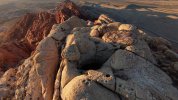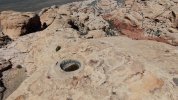Thanks everyone. Here is what the Geologist say about this area. I have found several sea shell fossils in these hills, so definetely under water in the past. ......
Geology of Red Rock Canyon

Red Rock Canyon NCA is home to a rich and complex geological history.
600 million years ago, the land that is now Red Rock Canyon NCA was at the bottom of a deep ocean and the coast was in present day western Utah. A rich variety of marine life flourished in those waters and left behind deposits of shells and skeletons more than 9,000 feet thick. These were eventually compressed into limestone and similar carbonate rocks.
Starting approximately 225 million years ago, crustal movements caused the sea bed to slowly rise. Streams entering the shallower waters deposited mud and sand which later consolidated into shale and marine sandstone. Changing land and sea levels also trapped large bodies of water. These later evaporated, leaving behind layers of salt and gypsum in some areas.
About 180 million years ago the area was completely arid, much as the Sahara Desert is today. A giant dune field stretched from Red Rock Canyon NCA eastward into Colorado, and windblown sand piled more than a half mile deep in some locations. As the wind shifted the sands back and forth, old dunes were leveled and new ones built up, leaving a record of curving, angled lines in the sand known as crossbeds. These shifting sands were buried by other sediments and eventually cemented into sandstone by iron oxide with some calcium carbonate. This formation, known locally as the Aztec Sandstone, is quite hard and forms the prominent cliffs of the Red Rock escarpment. Exposure to the atmosphere led to the iron minerals in some areas to oxidize, giving the rocks their red and orange colors.
The most significant geological feature of Red Rock Canyon NCA is the Keystone Thrust Fault. The Keystone Thrust is part of a large system of thrust faults that extends north into Canada and began to develop approximately 65 million years ago. A thrust fault is a fracture in the earth’s crust that is the product of compressional forces that drive one crustal plate over the top of another. This results in the oldest rocks on the bottom of the upper plate resting directly above the youngest rocks of the lower plate. At Red Rock Canyon NCA, the gray carbonate rocks of the ancient ocean have been thrust over the tan and red sandstone in one of the most dramatic and easily identified thrust faults found. The Keystone Thrust Fault extends from the Cottonwood Fault north, along State Route 160, for 13 miles along the crest of the Red Rock escarpment. It then curves east along the base of La Madre Mountain before it is obscured by very complex faulting north of the Calico Hills.














